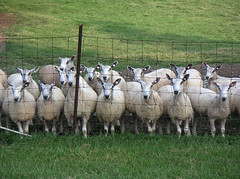 Sheep producers realize that sheep are very susceptible to copper toxicity and deaths can occur. The copper in COWP is very poorly absorbed, thus reducing the risk of copper toxicity. Goats are less susceptable to copper toxicity, tolerating up to 80 ppm.
Sheep producers realize that sheep are very susceptible to copper toxicity and deaths can occur. The copper in COWP is very poorly absorbed, thus reducing the risk of copper toxicity. Goats are less susceptable to copper toxicity, tolerating up to 80 ppm.COWP boluses can be made and adminstered on the farm using Copasure, a copper bolus marketed for copper deficiency in cattle. These boluses can be repackaged into doses suitable for sheep and goats. In research trials, the minimum dose that has demonstrated control is 0.5 g, but as much as 2-4 g may be necessary.
The FAMACHA system can be used to determine which animals should receive a COWP bolus. COWP should not be the only method used for controlling parasites.
To learn more about the use of COWP to control parasites in sheep and goats, read the 2007 fact sheet, "Tools for managing internal parasites in small ruminants: copper oxide wire particles." The fact sheet is a joint publication of NCAT/ATTRA and the Southern Consortium for Small Ruminant Parasite Control (SCSRPC).
